Biology students from Trinity University returned to the Texas Butterfly Ranch last week to continue battle with invasive species–specifically, Johnson grass. Four students arrived last Friday to take stock of an ongoing experiment that began last April on the banks of the Llano River and will continue through next year. The goal: figure out which methods are most effective in killing Johnson grass.
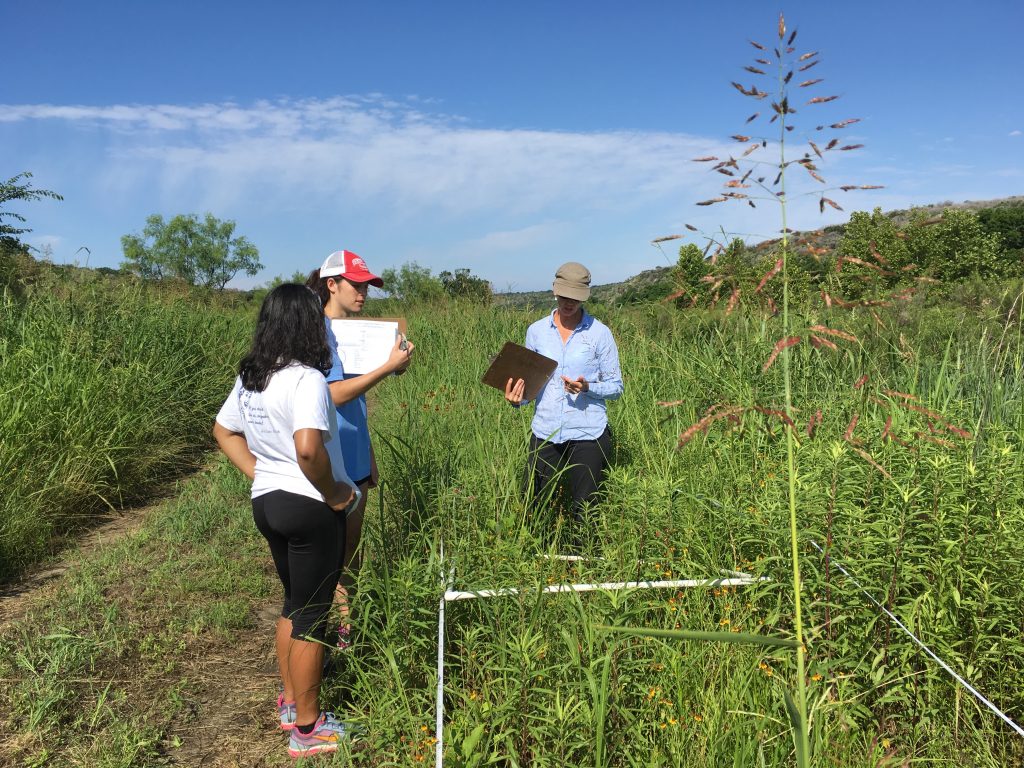
Levanya Hospeti and Molly Lenihan assist Dr. Kelly Lyons in collecting data for a Trinity University biology experiment. Foreground: Johnson grass. Photo by Monika Maeckle
“We successfully reduced Johnson grass abundance using both grubbing and herbicide,” said biology professor Dr. Kelly Lyons, a restoration ecologist and invasive plant expert who organized the experiment for her students. While it’s too soon to say whether grubbing (physically removing the Johnson grass) or herbicide (aquatic-safe glyphosate) is more effective, preliminary data suggest that where Johnson grass was reduced, biodiversity increased.
“We also found that in these rainy seasons, Goldenrod competes well with Johnson grass, albeit to the exclusion of most other species,” said Dr. Lyons.
That’s good news for migrating Monarch butterflies who use the late season bloomer as a nectar stop as they move through the Texas Funnel each fall on their way to Mexico.
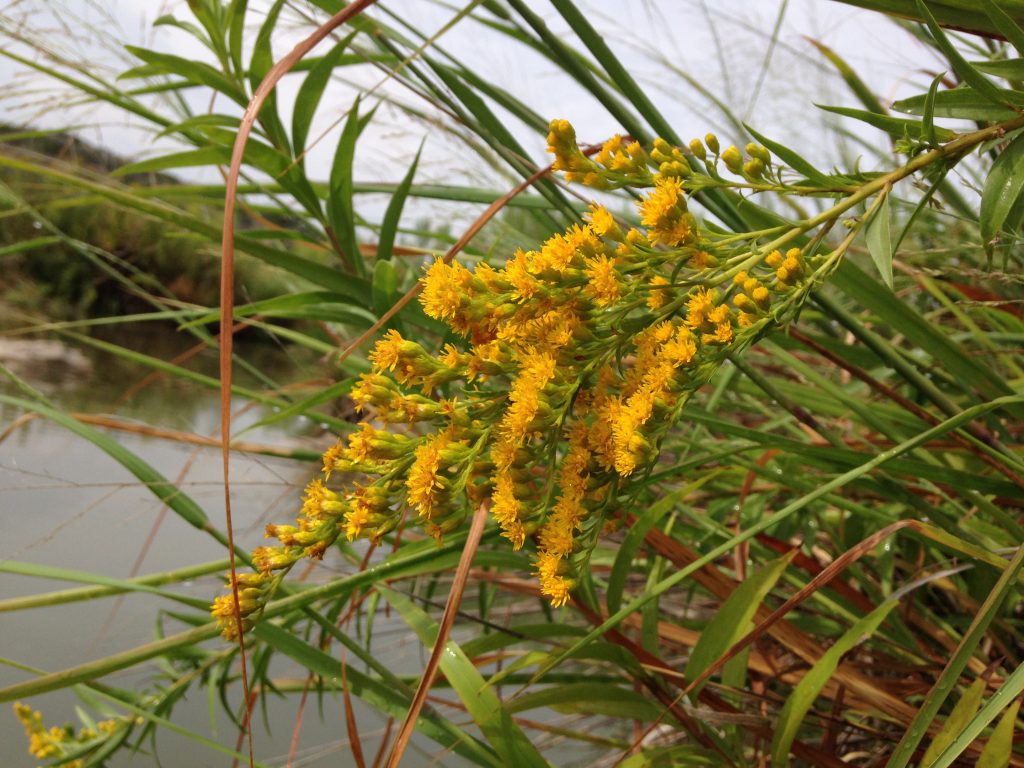
Goldenrod, a favorite nectar source for Monarch butterflies during the fall migration, competes will with Johnson grass and shields Swamp milkweed from harsh sun and flooding. Llano River, Texas Hill Country. Photo by Monika Maeckle
The project began last April as part of Trinity University’s ongoing research funded by the University, Texas Ecolab, and the National Science Foundation. Last spring, a team of students arrived at the ranch to set up plots and gather baseline data on plant density and diversity. Students established four 15- x 2-meter plots were established and applied different forms of Johnson grass control–grubbing, weedwhackjng, and herbicides, in various combinations.
On this visit, Levanya Hospeti, Molly Lenihan, Austin Philippe and Olivia Roybal joined Dr. Lyons to collect data and plant plugs of native Eastern gamagrass, Tripsicum dactyloides, a boisterous grower that Dr. Lyons believes can compete heftily with the rambunctious Johnson grass. Students planted 20 Eastern gamamgrass plugs and will continue monitoring the site over the course of the next year.
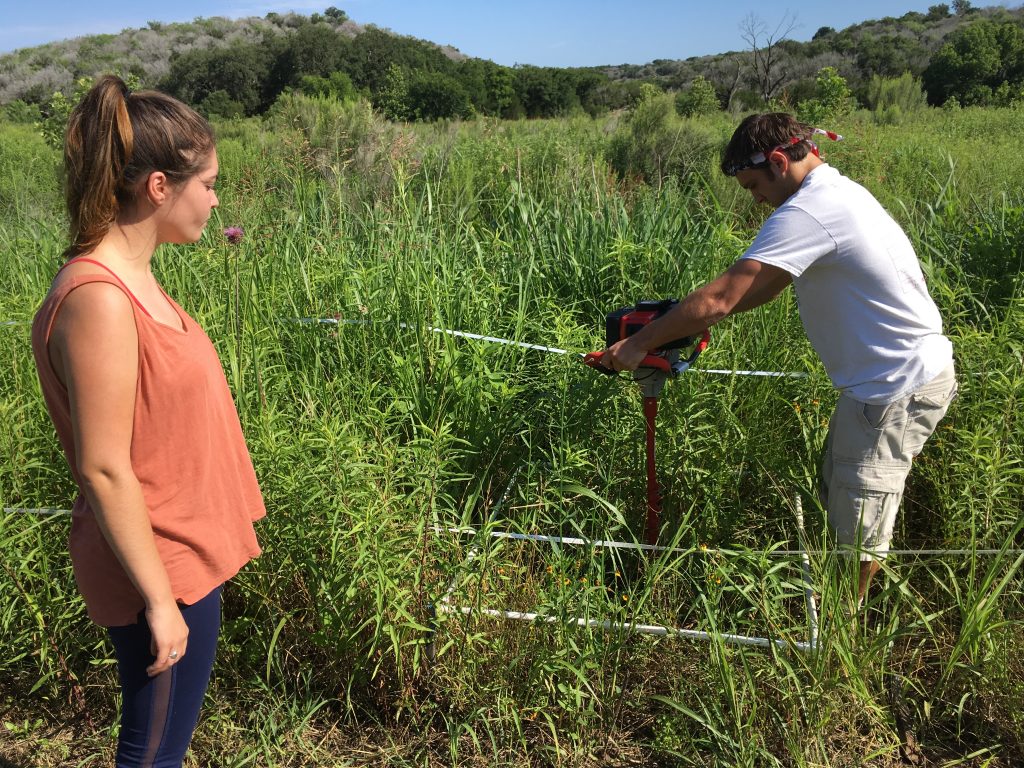
Olivia Roybel watches as Austin Phillipe drills a hole to plant Eastern gamagrass plugs. Photo by Monika Maeckle
Texas Invasives cites Johnson grass as one of the Top 10 Most Noxious weeds in the world. It arrived from the Mediterranean in the 1800s when it was imported as a supplementary foraging crop–even though when stressed, it can produce toxic amounts of hydrocyanic acid that makes it poisonous to livestock. The super aggressive grass spreads through rhizomes and seeds, hogs space and resources, and crowds out natives that provide food, fodder and shelter to local wildlife.
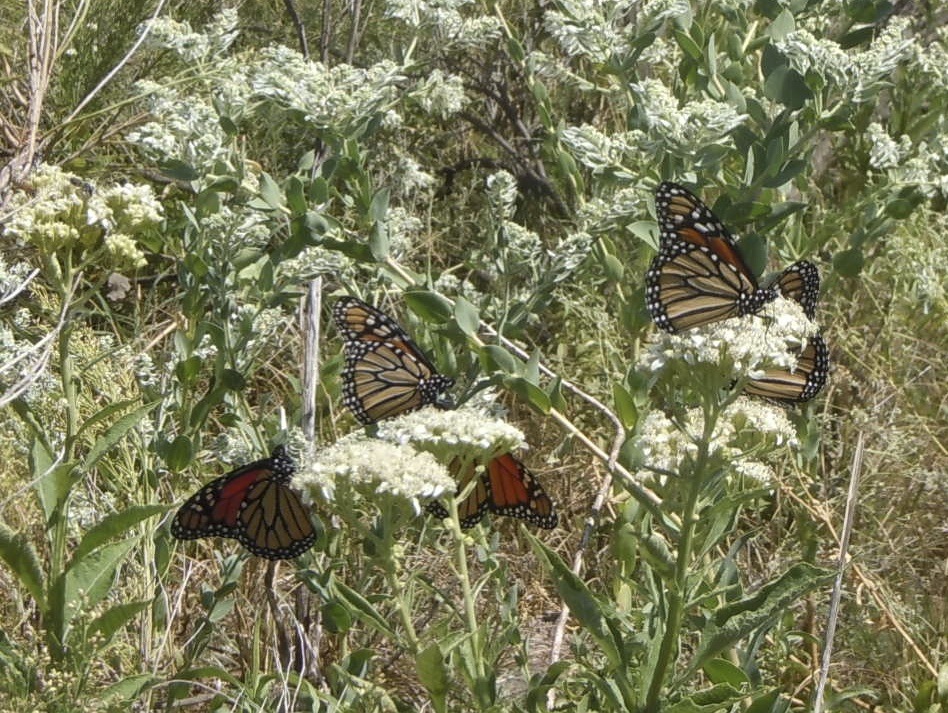
Monarch butterflies nectar on Frostweed along the Llano River in 2012. Now the native nectar source has to compete with Johnson grass. Photo by Monika Maeckle
For years we’ve enjoyed lovely stands of Goldenrod and Frosted on the Llano in the fall when the Monarchs pass through. Solidago altissima and Verbesina virginica, beautiful yellow and white late season nectar sources, respectively, serve as important fuel and resting stops for migrating Monarch butterflies and other creatures. But ever since a road project disrupted our stream bank and hauled in uninvited Johnson grass, we’ve been fighting the battle to win back our native nectar plants.
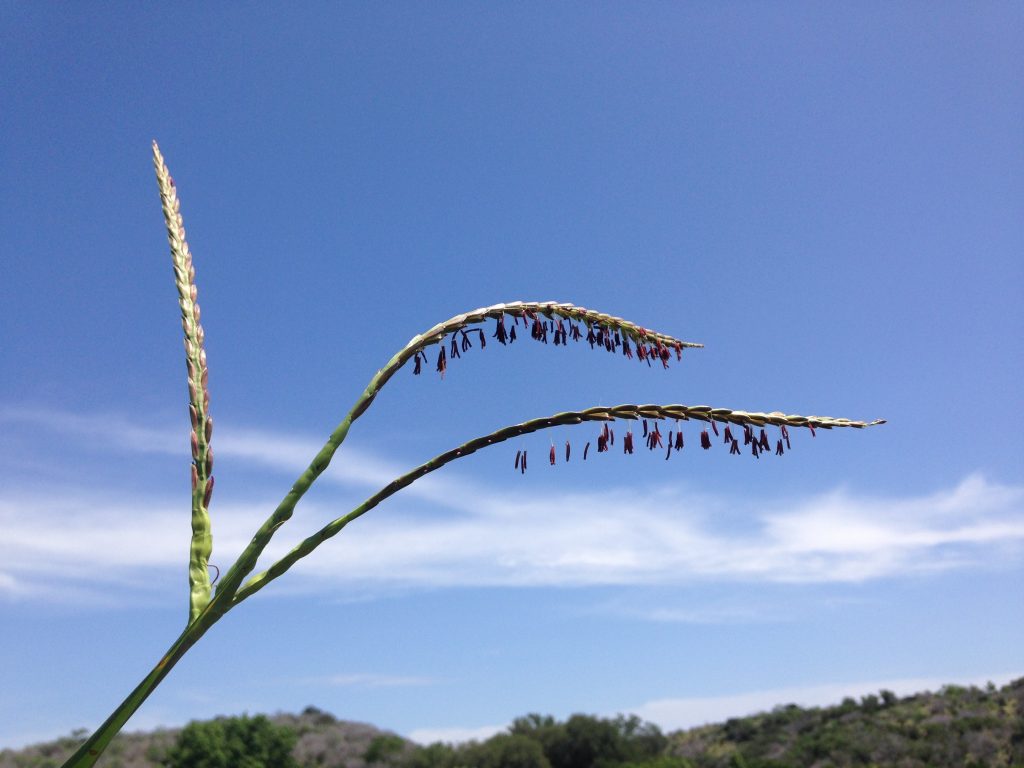
On the Llano River: Eastern gamagrass, a lovely native and host to the bunchgrass skipper. Photo by Monika Maeckle
Dr. Lyons thinks that the Goldenrod and Eastern gamagrass, a lovely, large bunchgrass related to corn that grows two – 10-feet tall, are up to the task.

Dr. Kelly Lyons
“The species is already present in high abundance and provides high quality habitat,” said Dr. Lyons, adding that Eastern gamagrass also works as a great soil stabilizer in river ecosystems. “Restoration ecologists often refer to it as ‘riparian rebar’ since its rhizomes are even more substantial than Johnson grass,” she said.
So the battle continues. No surprise that we’re rooting–pardon the pun–for Eastern gamagrass. It offers multiple benefits to our local creatures, including service as a host plant to the Bunchgrass skipper. It also appears to be a steady companion to our Llano River Swamp milkweed, Asclepias incarnata, host plant to Monarch butterflies. Tall mounds of Eastern gamagrass already occur naturally all along the Llano, providing shade for late season milkweed from harsh summer sun.
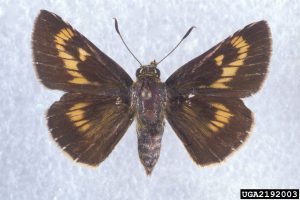
Bunchgrasss skipper hosts on Eastern gamagrass and other bunch grasses. Photo by Charles T. and John R. Bryson, Bugwood.org –
We spend a lot of time and energy talking about restoring native milkweeds and other pollinator plants to the prairies that we’ve lost. It’s equally important to manage and combat the advances of invasive species that infect our wildscapes. Johnson grass is just one interloper. Check out the Texas Invasives website for more information. We’ll keep you posted on the progress of the project.
Related posts:
- New study: nectar plants more important than milkweed for Monarch butterfly migration
- How to plan a successful pollinator garden
- Mostly native urban butterfly garden outperforms lawn every time
- IH-35 to Become Pollinator Corridor for Bees, Butterflies and other Pollinators
- Endangered Species Act: Wrong tool for the Job of Monarch butterfly Conservation?
- Texas Butterfly Ranch Native Texas Milkweed Guide
- A Year in the Life of a Mostly Native Urban Butterfly Garden
Like what you’re reading? Follow butterfly and native plant news at the Texas Butterfly Ranch. Sign up for email delivery, like us on Facebook, or follow us on Twitter, @monikam.

Quite a challenge to restore this habitat to native plants supportive of local species including the Monarch butterfly.
But I have to be concerned to hear about the use of “aquatic safe glyphosate”, an herbicide which has many negative effects including being listed by the WHO as a possible carcinogen. Not to mention glyphosate is the probable culprit in destroying milkweed which has led to the near extinction of the Monarch Butterfly. Who decided this chemical is aquatic safe? Monsanto? When will we humans learn to consider the unintended consequences of our actions?
Oh please.
Patricia,
You make an excellent point. My preference is always to use the least damaging approach, and chemicals are my last resort. In my research I lean toward fire for removal of invasives and that might be an option in this system; however, we did not hit the window to do that. In addition, it may not be practical in riparian systems where there may be enough fuel but the fuel can be too wet to ignite. So, we opted to test grubbing and glyphosate, two approaches very likely used by managers in a riparian context. Grubbing seems to be effective but we are doing this on small plots and took care to remove all rhizomes. When we applied the herbicide we did so using tongs covered in sponges and applied the herbicide to ONLY Johnsongrass, taking care not to spill the herbicide on any other plants. Again, this might not be realistic in a large-scale management context BUT in this capacity you could imagine a crew of 5-6 people knocking out an acre or so in a day. And this might just give the natives a chance.
Regarding Monsanto’s (among other’s) role in all of this. As a weed ecologist my conferences are disturbingly dedicated to control of weeds through herbicide application. People like me try to stay involved in this dialogue because where money is to be made you cannot completely trust that the best management recommendations are being made and we need to be simultaneously testing alternatives. Unfortunately, for some species, like Johnsongrass, Arundo, Kudzu, etc…, the alternatives, like mechanical removal (grubbing) can lead to large-scale disturbance, resulting in long-term return of invasives, particularly if there is no post-disturbance restoration, or increased spread due to failure to manage small pieces of the species. For example, Arundo can regenerate from just a single piece of stem, as long as there is a node, and rhizomes of Johnsongrass are evolved to regenerate readily. So, if care is not taken in the removal process you make headaches for folks downstream, both spatially and temporally… So, while I am myself very opposed to using herbicide, especially where other options have not been fully considered, there are most definitely times when they can be used judiciously. It is CRITICAL however that post-removal restoration be done so that the species does not return and this is why we are testing Eastern gamagrass as a post-removal biocontrol option, although goldenrod is doing some of this work for us!
I so look forward to your blog. My wife and I live in Laredo (Webb County) and we are proud of our small backyard wildlife garden well planted with South Texas natives. I look forward to meeting you in person one day when we travel to San Antonio, possibly during one of your “clinics” at the Botanical Gardens. Thanks for your great work.
Aquatic safe or not, glyphosate is not the answer!! Might make it easier for us humans, but any chemical solution is not in harmony with nature, is not natural, and is harmful to the environment & ultimately harming ourselves in the process, again. Will we humans ever learn to coexist, not solving one problem by creating another, advertently or inadvertently. Ignorance is how the invasive species got there in the first place! Wake up please.
I agree that “not going there in the first place” is the answer. And all invasive species specialists, like myself, advocate for Early Detection/Rapid Response (EDRR) but this requires a way of “waking up” that most humans are not willing to do. Many people dont even know they have an invasive species problem until habitat is homogenized. I challenge anyone who is completely against ANY use of herbicides, even judicious use (see my comment above), to try to remove Arundo or Johnsongrass on an area greater than one acre and get back to me with their experiences. I’ve been at this for 20 years. I’ve dedicated my life to it and, again, as mentioned above, prefer to NOT use chemicals. But, we are not in harmony. We typically do not co-exist. We must look for solutions that result in the greatest good for the native biodiversity and have the smallest impact in the short- and long-term.
Thanks for the great pictures. Growing up in West Texas (Lubbock), I never saw a lot of butterflies. Its good to know that wildlife exists out there.
Thanks
It is stupefying that glyphosate was used. Have you failed to notice from March 25 2015 Scientific American:
“The cancer-research arm of the World Health Organization last week announced that glyphosate, the world’s most widely used herbicide, is probably carcinogenic to humans.”
PANNA has also provided much information on this poison. ” France officials were motivated to take a closer look at the herbicide formulation when, last November, the European Food Safety Agency (EFSA) released findings that glyphosate formulations in combination with other chemicals have greater potential health risks than glyphosate on its own. This is particularly concerning given last year’s determination from the World Health Organization’s International Agency for Research on Cancer (IARC) that glyphosate is a “probable human carcinogen.””